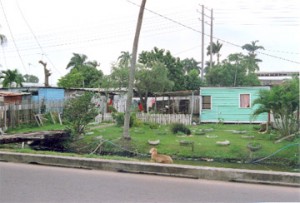The caption in the Stabroek News of August 19 ‘Railway Squatters to get moving help from gov’t’ gave hope that serious attention was being given to a serious problem. But financial assistance in moving from the railway embankment is not the major need. The railway residents have heard that the land allocated to them on the West Bank Demerara is low-lying and has no water or electricity service. The removal decision has therefore caused consternation; a water service is essential.
Senior citizens plead that they have spent their youth in building the railway embankment into a kitchen and fruit garden, and now they do not have the energy to make a fresh start. They will not be happy until this problem is solved. They are also concerned about meeting living expenses after they move, because their first crops will still be growing, and also about finding markets when the final products are ready.
It is widely believed that these residents are squatters. However, I have seen letters that were written to two of them by government agencies, and there is clear evidence in these instances that this was not the case. Many others may also have sought to have their occupation legalized.
In 1978 the Lands and Surveys Department in the Ministry of Agriculture wrote to the occupant of Lot 6 Railway Line, Camp and Lamaha Streets, Opposite Hanoman House in these terms:
“Reference is made to your application dated 17th April, 1978, for permission to occupy a tract of 38 feet by 50 feet state land situate on the southern and northern sides of the East Coast Railway Line about 226 feet from the centre line of Camp Road, and to inform that Government [has given annual permission for the tract – not clear] at an annual rental of $1 per square rod.
“As such, you would be required to pay annually the sum of $18.19.

“Kindly call at the above mentioned office early to state your approval of the aforementioned proposal.”
That correspondence was in 1978. In 1994 there is a letter from the Central Housing and Planning Authority about plots on the Railway Line written to the family member who now occupies that same tract of land. The Chief Executive Officer wrote:
“The decision has been taken to allocate a plot of land to you for residential purposes.
“We are pleased to inform you that we will be accepting payment of $8000 which represents the cost of the unserviced plot of land together with design and survey services.
“We would like you to walk with any form of identification and to be present at the Central Housing & Planning Authority between 1st May and 30th July 1994.
“In addition you will get the opportunity to see the layout for the scheme and you will be invited subsequently to a meeting whereby you will be given the chance to choose your plot by way of lottery.
“Should you fail to respond to this offer of allocation within one (1) month, it will be assumed that you are no longer interested and the application will be null and void.”
The sum of $8000 was paid. And the applicant remains on the plot to this day.
The uncertainty of the services available at the West Bank location offered, the nature of the soil and the lack of infrastructure are causing distress to those who have been assigned land there.
What seems to be needed is a Round Table discussion with the relevant government officials and the Guyana Consumers Association to iron out the difficulties. Those who paid for their Railway Line plots should have their money refunded at today’s value. Let Peace and Harmony reign.





